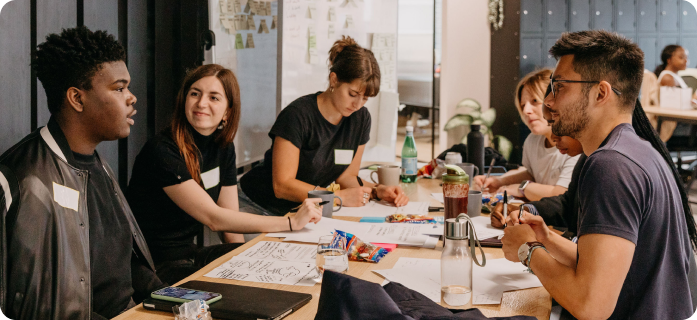A Conversation About Design: UX/UI Design within the Media Industry (Part One)
Kojo Boteng is a multifaceted and award-winning designer and educator, and currently sits as the Creative Director at PBS NewsHour.
Originally from South London but now living in Washington, DC, he was formerly creative director at ITN and ITV News in the UK and has also worked with a wide range of media projects for Capital One, Complex Media, NPG Group, BBC, ITV and Universal Music. He’s currently an adjunct professor and mentor at NYU Tandon School of Engineering, where he teaches UX design. He is also the founder of Create Community, a series of initiatives that elevate the work of Black and underrepresented designers, artists, and creatives. His work has been featured in the Design Week, Creative Review, The Guardian, The Times, and The Telegraph here in the UK.
In this episode of A Conversation About Design, we go beyond the surface as we explore the mindset, challenges and successes that have defined Kojo’s impressive career.
Can you tell us a bit more about your work at PBS NewsHour?
“I’ve been at PBS NewsHour for about three and a half years, having joined during the pandemic. For those who don’t know, PBS in the United States is public broadcasting. So kind of similar to the UK, although the funding model is a little bit different, and what I work on is the News Hour, which is a daily news bulletin of the day, but what’s slightly different about the news hour because of the way it’s funded, we can go into a lot more detail on in-depth stories and topics whether that’s social justice, criminal justice, the environment etc. as well as whatever the big news story of the day is, whether it’s the election, the Israel Hamas war, that sort of thing.
In my role I’m managing a small team of designers who produce graphics for the program. Now, when most people think of television graphics, they always think it’s the little name strap that comes up. That’s part of it, but we’re also essentially helping journalists and correspondence producers to visualise their stories. So, a good example might be when the Alaska Airlines door flew off, we might be asked to produce a map of what time the flight took off, when the incident happened, where it was rooted to, what time it landed and how many people might be injured. This is the kind of story that’s very difficult to tell with just words when there’s no picture. So that’s when a graphics person comes in to work with the journalist to figure out what are the facts and how can we visualise that so people at home can understand what’s happening.”
What do you think your work is going to look like later on this year, especially going into election year?
“Elections are like the bread and butter of what a news organisation does. It’s usually the time when the most money gets spent because you have a lot of data to show. Big organisations tend to want all the bells and whistles: video walls, touchscreens and all that kind of stuff. So that project is a very big one for us, and always has been since I started my career in the news.
Another project that we’re working on at the moment is a rebrand of the whole show. We’re working with an outside agency on the design of the logo and thinking about our branding architecture and how that fits with PBS and all that kind of stuff. We need to think about tone of voice, how are we presenting ourselves, how do we continue to engage audiences on platforms like YouTube and TikTok and what role design and storytelling play in that.”
How does this work compare to what you were doing at ITN, ITV News, and BBC?
“I started at ITN in 1998 and it was my first job outside of college. I graduated with my MA in documentary filmmaking having already got an undergrad in graphic design. I ended up getting the job at ITN and worked my way up the ranks to Creative Director.
My role and journey in news is very much the foundation of what I have done. The skills that I learned in terms of communication, just how to work with diverse teams, whether it’s with directors, producers, camera people, lighting people, studio managers, set designers, etc. I should also mention that when you work in news it’s super fast so where most designers get brief and maybe have a couple of weeks or a month to complete it, if it’s a big project we sometimes only have about an hour to turn something around! This way of designing makes you think quickly and iterate quickly, which is good, but when you do have longer to work on a project it can be difficult to shift gears and think ‘oh I have more time to work this’.”
What prompted the move from London to Washington? How did you come about that? Have you had to adapt to different working styles and ethics?
“What prompted the move was my partner as she’s American! It was a chance to see whether the relationship was going to work, and it has as we’ve been married now for five years.
I’m very much a no risk, very safe type of person, so for me to up-sticks after so many years of living and working in London was in hindsight, quite a big move…and it wasn’t easy! It’s very, very challenging moving to a different country. I did know a few people but I certainly didn’t have the massive friendship network like I had in London. So that was a challenge, that actually still continues to this day in terms of creating good friendships, as well as good working relationships.
So far, my experience of working in America has been interesting as the culture is so different. It might just be a DC thing, but people are more uptight here! It could also be to do with the climate but you definitely couldn’t get away with some of the things you can say and do in the UK. I would say that work is one of the great things about the States because there are so many opportunities, which I think also has to do with the can-do attitude that Americans have. There’s better support, both financial and mentorship and those kinds of things. So I would say that it’s pretty much a country of entrepreneurs, whereas in London I know so many people who are talented that are probably not going to go anywhere, but here given its scale, there’s a lot of opportunities if you find the right path.”
Stay tuned for Part 2…
This article forms part of a discussion conducted between Kojo Boteng and Experience Haus Creative Director, Amit Patel on the Experience Haus podcast, ‘A Conversation About Design’. In this podcast, we explore the fascinating world of design featuring insightful conversations with some of the brightest minds and inspiring individuals who are making waves in the industry.
Listen to the full interview with Kojo here.




